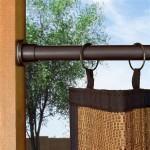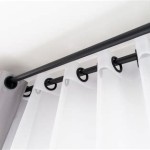4 Inch Curtain Rod Brackets: A Comprehensive Guide
Curtain rod brackets are fundamental components of any window treatment system. They serve as the primary support structure, ensuring the stability and functionality of curtain rods. The selection of appropriate brackets is crucial for a successful and aesthetically pleasing window dressing. Among the diverse range of bracket sizes, the 4-inch curtain rod bracket occupies a specific niche, offering unique advantages in certain applications.
This article aims to provide a comprehensive understanding of 4-inch curtain rod brackets, exploring their characteristics, applications, materials, and installation considerations. By understanding the nuances of these brackets, individuals can make informed decisions when selecting the right supports for their window treatments.
Understanding 4-Inch Curtain Rod Bracket Dimensions and Applications
The defining feature of a 4-inch curtain rod bracket is its projection, the distance it extends from the wall to the center of where the curtain rod will sit. This 4-inch projection offers a specific set of benefits compared to brackets with shorter or longer projections. This dimension is particularly relevant when considering the depth of window features like trim, blinds, or other existing window coverings.
One primary application of 4-inch brackets is accommodating window treatments with substantial depth. For example, if blinds are already installed within the window frame, a 4-inch bracket allows curtains to hang in front of the blinds without interference. This prevents the curtains from rubbing against the blinds, which can cause damage or hinder their operation. Similarly, windows with deep sills or decorative trim may require the added projection to ensure the curtains hang properly and do not bunch up against the window frame.
Another common use case is layering window treatments. The 4-inch projection allows for installing two separate curtain rods, one closer to the wall for sheers or lighter fabric, and another further out for heavier drapes. This creates a layered look, adding dimension and functionality to the window treatment. The ability to control light and privacy independently with layered curtains is a significant advantage of using brackets with adequate projection.
Beyond functional considerations, the projection of the bracket also affects the aesthetic appeal of the window treatment. A 4-inch projection can create a more pronounced visual separation between the curtain and the wall, adding depth to the room. This can be particularly desirable in rooms with limited space, where even subtle design elements can contribute to a feeling of spaciousness.
It is important to consider the overall room size and window dimensions when choosing a 4-inch bracket. In smaller rooms, a bracket with a shorter projection may be more visually proportionate. Conversely, in larger rooms with expansive windows, the added projection of a 4-inch bracket may be necessary to balance the visual weight of the window treatment.
Materials and Construction of 4-Inch Curtain Rod Brackets
The durability and load-bearing capacity of a 4-inch curtain rod bracket are directly influenced by the materials used in its construction. Common materials include metal alloys, wood, and plastics, each offering distinct advantages and disadvantages.
Metal brackets are generally the most robust, providing superior strength and longevity. Steel and iron are popular choices, offering high load-bearing capacity suitable for heavier curtains and drapes. These materials are often finished with powder coating or plating to resist corrosion and enhance their aesthetic appeal. The strength of metal brackets makes them ideal for situations where the curtains will be frequently opened and closed, or where they are exposed to significant wear and tear.
Wood brackets offer a more traditional and decorative aesthetic. They are often crafted from hardwoods like oak or maple, providing a natural and warm appearance. Wood brackets are suitable for lighter to medium-weight curtains. It's crucial to note that wood brackets may be more susceptible to damage from moisture or fluctuations in temperature and humidity. A proper seal and finish is necessary to prolong the life of wooden brackets.
Plastic brackets are typically the least expensive option, but they also offer the lowest load-bearing capacity. While suitable for very lightweight curtains, they are generally not recommended for heavier fabrics or frequently used window treatments. Plastic brackets are often used in temporary or budget-conscious applications.
The construction of the bracket also plays a critical role in its strength and stability. Brackets with a solid base and reinforced arms are better equipped to support heavier loads. The method of attachment to the wall is equally important. Brackets that are secured with multiple screws and anchors provide a more stable and secure installation. The quality of the screws and anchors should also be considered, as inferior hardware can compromise the integrity of the installation.
Some 4-inch curtain rod brackets feature adjustable arms, allowing for fine-tuning of the projection. This adjustability can be particularly useful when dealing with irregular wall surfaces or when precise alignment is required. Adjustable brackets also offer greater flexibility in accommodating different curtain rod diameters. The adjustability feature allows for ease in leveling and centering the curtain rods.
Installation Considerations for 4-Inch Curtain Rod Brackets
Proper installation of 4-inch curtain rod brackets is essential for ensuring the stability and functionality of the window treatment. Incorrect installation can lead to sagging curtains, damaged walls, or even the complete failure of the bracket system. Careful planning and attention to detail are crucial for a successful installation.
The first step is to determine the desired height and placement of the brackets. A general rule of thumb is to position the brackets 4-6 inches above the window frame. This allows the curtains to extend beyond the window, creating a sense of height and spaciousness. The distance between brackets should be determined by the length of the curtain rod and the weight of the curtains. For heavier curtains, shorter spans between brackets are recommended to prevent sagging. The placement should be symmetrical and visually balanced.
Before drilling any holes, it is important to locate wall studs. Securing the brackets directly to wall studs provides the strongest and most stable installation. A stud finder can be used to accurately locate the studs behind the drywall. If studs are not available in the desired location, appropriate wall anchors should be used. The type of anchor will depend on the weight of the curtains and the type of wall material. Toggle bolts, molly bolts, and heavy-duty drywall anchors are suitable options for supporting heavier loads.
When drilling holes for the screws or anchors, it is important to use the correct drill bit size. A pilot hole that is too small can make it difficult to drive the screws in straight, while a hole that is too large will provide inadequate support. The manufacturer's instructions for the brackets and anchors will typically specify the recommended drill bit size. When installing into drywall, avoid over-tightening, as this strips the surrounding material and reduce holding power.
After the brackets are secured to the wall, the curtain rod can be installed. Ensure that the rod is properly seated in the bracket cradles and that it is level. A level can be used to verify that the rod is perfectly horizontal. If necessary, shims can be used to adjust the height of the brackets and ensure a level installation. Be careful to conceal any shims used.
Finally, the curtains can be hung on the rod. Distribute the weight of the curtains evenly along the rod to prevent sagging or uneven distribution of stress on the brackets. Check the stability of the entire system by gently tugging on the curtains. If there is any movement or instability, re-evaluate the installation and make any necessary adjustments. Secure the curtains rings or hooks to the rod, checking that it glides easily.

Adjustable 4 5 In Curtain Rod Brackets Heavy Duty Bracket Holder For 8 To 3 Inch Rods Wall

4 1 Return Iron Bracket Color Charcoal

Adjustable 4 5 In Curtain Rod Brackets Heavy Duty Bracket Holder For 8 To 3 Inch Rods Wall

Ona Drapery Custom Brace Standard Wrought Iron Curtain Rod Bracket

4 3 To 5 1 Inch Return Bracket Color Black

Adjustable 4 5 In Curtain Rod Brackets Heavy Duty Bracket Holder For 8 To 3 Inch Rods Wall

Bronze Color Heavy Duty Curtain Rod Brackets For 3 4 Or 5 8 Inch Pack

Wl4 Bracket For 2 Or 1 4 Curtain Rods 3 Return Each

4 Pcs 11 Inch Curtain Rod Bracket Ceiling Mount Holder Flange Clos

Conversion Double Curtain Rod Brackets 1 In 3 4 2 Pk








